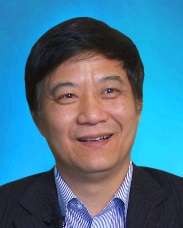 Ben Zhong Tang is an Associate Editor for Polymer Chemistry and a Chair Professor in the Department of Chemistry, The Hong Kong University of Science & Technology (HKUST), China. His research focuses on the synthesis of new molecules and polymers with novel structures and unique functions and the exploration of their high-tech applications as advanced materials in life science, optoelectronic devices, etc.
Ben Zhong Tang is an Associate Editor for Polymer Chemistry and a Chair Professor in the Department of Chemistry, The Hong Kong University of Science & Technology (HKUST), China. His research focuses on the synthesis of new molecules and polymers with novel structures and unique functions and the exploration of their high-tech applications as advanced materials in life science, optoelectronic devices, etc.
You can find all Editorial Board’s Top Picks papers in our web collection
Focus on Luminogenic Polymers (Associate Editor: Prof. Ben Zhong Tang, HKUST, China)
1. A fluorescent supramolecular polymer with aggregation induced emission (AIE) properties formed by crown ether-based host–guest interactions
Dong Chen, Jiayi Zhan, Mingming Zhang, Jing Zhang, Jiaju Tao, Danting Tang, Ailin Shen, Huayu Qiu and Shouchun Yin
Polym. Chem. 2015, 6, 25–29.
Supramolecular polymers are a group of novel macromolecules with their monomeric units self-assembled together through monovalent interactions. S. Yin and coworkers at Hangzhou Normal University (China) and University of Maryland (USA) have synthesized a new supramolecular polymer by utilizing crown ether-based host–guest interactions. The supramolecular polymer shows aggregation-induced emission, thanks to the tetraphenylethene units imbedded in the macromolecular chain. Its fluorescence intensity is decreased dramatically on the addition of Pd2+ due to the coordination of the metal ion with the triazole group, enabling the polymer to find practical application as a fluorescent chemosensor.
2. Amphiphilic fluorescent copolymers via one-pot combination of chemoenzymatic transesterification and RAFT polymerization: synthesis, self-assembly and cell imaging
Zengfang Huang, Xiqi Zhang, Xiaoyong Zhang, Changkui Fu, Ke Wang, Jinying Yuan, Lei Tao and Yen Wei
Polym. Chem. 2015, 6, 607–612.
Fluorescent organic nanoparticles (FONs) have attracted much attention. Many FONs, however, are hydrophobic particles and have been fabricated by non-covalent strategies. Z. Huang and coworkers at University of Electronic Science & Technology of China and Tsinghua University have combined radical polymerization and enzymatic transesterification processes and developed a one-pot covalent procedure for the fabrication of FONs with aggregation-induced emission (AIE) attribute. The amphiphilic chains of the obtained polymers self-assemble into spherical FONs with the hydrophobic AIE cores covered by hydrophilic poly(ethylene glycol) shells. The FONs show excellent dispersibility in aqueous media, compatibility with biological species, and performance as bioimaging reagent.
3. Aggregation-induced circularly polarized luminescence of an (R)-binaphthyl-based AIE-active chiral conjugated polymer with self-assembled helical nanofibers
Shuwei Zhang, Yuan Sheng, Guo Wei, Yiwu Quan, Yixiang Cheng and Chengjian Zhu
Polym. Chem. 2015, 6, 2416–2422.
A number of polymers with atomic chirality have been found to emit circularly polarized luminescence (CPL). Polymers with axial chirality, however, have been rarely prepared. A team led by Y. Cheng and C. Zhu at Nanjing University (China) have synthesized a series of conjugated polymers containing (R)-binaphthylene and tetraphenylethene (TPE) units with axial chirality and aggregation-induced emission (AIE). All the polymers show AIE effects, thanks to the TPE units embedded in the polymer chains. When the polymers form aggregates in aqueous mixtures, a polymer with the “right” structure becomes CPL active. The aggregation-induced CPL effect of the polymer is tunable by changing the water content of the aqueous mixture.
Review article
Luminescent polymers and blends with hydrogen bond interactions
Shih-Hung Huang, Yeo-Wan Chiang and Jin-Long Hong
Polym. Chem. 2015, 6, 497–508.
Macromolecular luminogens with aggregation-induced emission (AIE) characteristics are useful functional materials because they emit strongly in the aggregate or solid state. As the restriction of intramolecular rotations of luminogens is the main cause for the AIE activity, it has been envisioned that hydrogen-bond interactions can be utilized to construct AIE-active polymers. J.-L. Hong and coworkers have summarized the research effort in the area of AIE study. Through appropriate choices of H-bonding units and sites, a variety of AIE-active polymers and blends have been conveniently generated. In the polymers containing multiple luminogen units, the entangling polymer chains and the intermolecular H-bonding interactions impose effective rotational restriction on the luminogens. In the hydrophilic polymers carrying single luminogens, ready aggregation of the hydrophobic luminogens from the phase-separated H-bonding sites reinforces the beneficial rotational restriction, resulting in AIE systems with intense light emissions. In the luminogenic polymer blends consisting of H-bonding donors and acceptors, the preferable intermolecular H-bond interactions effectively hamper the motion of the constituent components. Thanks to the effective intermolecular H-bond interactions, the blends emit more efficiently than their pure luminogen counterparts without H-bond interactions.










